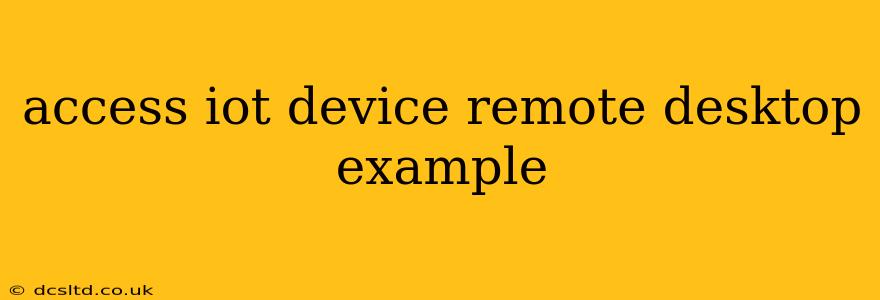The Internet of Things (IoT) is rapidly expanding, connecting various devices to the internet. Managing and troubleshooting these devices often necessitates remote access to their desktops. However, accessing an IoT device's remote desktop presents unique challenges compared to accessing a traditional computer. This guide will explore the methods, security considerations, and best practices for accessing IoT device remote desktops securely and efficiently.
What are the common methods for accessing an IoT device's remote desktop?
Several methods enable remote desktop access to IoT devices, each with its strengths and weaknesses. The most common include:
-
VNC (Virtual Network Computing): VNC is a widely used and relatively simple protocol for remote desktop access. Many IoT devices support VNC, allowing you to view and control the device's desktop remotely. However, VNC's security can be a concern if not properly configured.
-
RDP (Remote Desktop Protocol): While more commonly associated with Windows, some embedded systems and IoT devices support RDP. This provides a robust and feature-rich remote desktop experience, but requires proper configuration and security measures.
-
SSH (Secure Shell): SSH primarily provides secure command-line access, but with tools like X11 forwarding, you can also access a graphical desktop environment remotely. This offers strong security compared to VNC or unencrypted RDP. However, it requires a more technical understanding.
-
Custom Solutions: Depending on the IoT device and its operating system, there may be custom solutions or APIs developed by the manufacturer to provide remote access capabilities. These solutions often offer better integration but might lack the wider community support of common protocols like VNC or RDP.
What are the security implications of remotely accessing IoT devices?
Remotely accessing IoT devices introduces significant security risks. These devices often have limited processing power and security features, making them vulnerable to attacks. Consider these security implications:
-
Weak Passwords and Default Credentials: Many IoT devices ship with weak or default passwords, making them easy targets for hackers. Always change these credentials immediately after installation.
-
Unencrypted Connections: Using unencrypted protocols for remote access exposes your data to interception. Always prioritize secure connections using SSH, encrypted VNC, or encrypted RDP.
-
Lack of Firewall Protection: Many IoT devices lack proper firewall configurations, making them vulnerable to unauthorized access attempts. Implement robust firewall rules to limit access to authorized users and ports.
-
Malware and Viruses: IoT devices can become infected with malware or viruses through compromised remote access points. Keep the device's firmware and software updated with security patches.
How can I secure remote access to my IoT devices?
Implementing robust security measures is crucial for protecting your IoT devices from unauthorized access. Here are some key recommendations:
-
Use Strong and Unique Passwords: Employ strong, unique passwords for each IoT device and use a password manager to help keep track.
-
Enable Encryption: Always use encrypted protocols like SSH, encrypted VNC (using a VPN, for example), or encrypted RDP.
-
Configure Firewalls: Configure both the IoT device's firewall and your network's firewall to limit access to only authorized IP addresses and ports.
-
Regular Software Updates: Keep your IoT devices' firmware and software up-to-date to patch known vulnerabilities.
-
Multi-Factor Authentication (MFA): If available, enable MFA for an extra layer of security.
What are some best practices for managing remote access to IoT devices?
Beyond security, efficient management is vital. Consider these best practices:
-
Centralized Management: Use a centralized management system to monitor and control multiple IoT devices from a single console.
-
Regular Audits: Regularly audit the security settings of your IoT devices to ensure they are properly configured.
-
Access Control Lists (ACLs): Implement ACLs to restrict access to specific users and groups.
-
Logging and Monitoring: Enable detailed logging to track access attempts and identify suspicious activity.
What are the different operating systems that support remote desktop access?
Many operating systems used in IoT devices support various remote access methods. Common operating systems include:
-
Linux: Linux distributions often have robust support for SSH, VNC, and other remote access methods.
-
Embedded Linux: Many embedded Linux distributions are optimized for IoT devices and provide similar remote access capabilities.
-
FreeRTOS: While not typically associated with graphical remote desktops, FreeRTOS-based devices can still offer remote access through command-line interfaces and custom APIs.
The availability of specific protocols like RDP varies widely depending on the specific operating system and its configuration.
This guide provides a comprehensive overview of accessing IoT device remote desktops. Remember that security is paramount. By following these security best practices and selecting appropriate protocols, you can ensure secure and efficient remote management of your connected devices.
